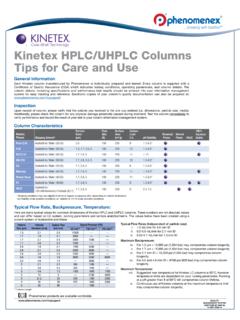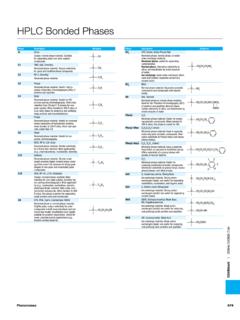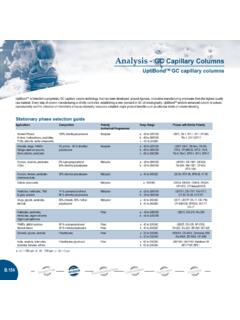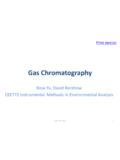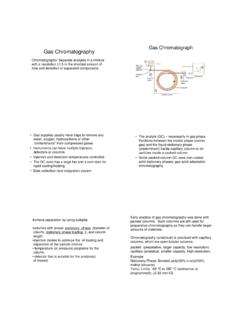Transcription of GC Columns GC COLUMN - Phenomenex
1 INSTALLATION GUIDEG C GC Columns2 TROUBLESHOOTING TOOLS Flow meter Leak detector New syringe COLUMN performance test sample Methane or other non-retained compound Reference COLUMN New septa, ferrules and injector liners Instrument manualsPRE-INSTALLATION CHECKLIST Replace oxygen, moisture and hydrocarbon traps as necessary. Check gas cylinder pressures to ensure that an adequate supply of carrier, make-up and fuel gases are available. Carrier gases should be of the highest purity. Note: It is critical that oxygen and water be removed from the carrier gas by the appropriate use of filters and COLUMN INSTALLATION STEPS Ensure that the injection port is clean and free of sample residues, septum, or capillary debris. Check and replace as necessary critical injector components such as seals, liners, and septa.
2 Check and replace detector seals as necessary. Carefully inspect your COLUMN for damage or INSTALLATIONNote: GC Columns do not have a specific directional flow when received from the manufacturer. Upon initial use of your new ZebronTM COLUMN , Phenomenex recommends the practice of dedicating one specific end of the COLUMN for injector installation only. This is particularly important when dealing with active/caustic or contaminating com-pounds. If these compounds are routinely injected onto the COLUMN , degradation of the phase will occur leading to higher bleed. A typical first step to remedying (remov-ing) this bleed would be to trim 10 cm from the front (in-jector) end of the COLUMN and keep trimming this inlet end of the COLUMN as necessary.
3 Trying to remedy any bleed issues by trimming the COLUMN may not work if both ends have been interchangeably installed into the Place a capillary nut and ferrule on the injector end of the GC COLUMN , allowing a section of COLUMN to protrude. Trim one to two centimeters from the protruding end to remove ferrule contamination that may have entered the COLUMN . Inspect the cut with a magnifier to ensure that a smooth, clean, square-cut edge has been made - recut if necessary. See figure on p. Carefully hang the COLUMN in the GC oven, being cautious not to scratch or damage the polyimide coating on the capillary tubing. Rotate the COLUMN to avoid sharp bends of the capillary COLUMN and any contact of the COLUMN with oven surfaces.
4 3. Insert the COLUMN into the injector exactly the correct distance specified in the instrument manual. Tighten the ferrule nut finger-tight then 1/2 turn with a wrench. If the COLUMN can still be moved, tighten another 1/4 turn until the COLUMN is Adjust the carrier gas to obtain the flow rate listed on the test chromatogram. 3 CRITICAL COLUMN INSTALLATION STEPS (cont d)DETECTOR INSTALLATIONNote: For users with sensitive detectors such as MS and ECD, COLUMN conditioning steps should be performed be-fore installing the COLUMN to prevent contamination and frequent maintenance of the Place the COLUMN nut and ferrule past the end of the COLUMN and cut a centimeter or two off the end of the COLUMN . Be sure that the ferrule is the right size and pointing in the correct direction.
5 Inspect the cut with a magnifier and ensure that the cut is square and smooth. See figure below. Recut if Insert the outlet end of the COLUMN into the detector exactly the distance prescribed in the instrument manual. Distances will vary between detectors. Tighten the ferrule nut finger-tight then 1/2 turn with a wrench. If the COLUMN can still be moved, tighten another 1/4 turn until the COLUMN is Inspect the COLUMN connections for leaks using an electronic leak detector. Leaks at the inlet end may introduce oxygen to the COLUMN that will result in increased COLUMN bleed and damage to the COLUMN CONDITIONING1. Allow sufficient time for the carrier gas to flow through the COLUMN to purge any oxygen that may be in the system.
6 2. Raise the temperature of the COLUMN to the maximum isothermal operating temperature that is listed on the individual ZebronTM GC COLUMN Test Report. Maintain this temperature until a constant baseline is achieved. Conditioning times will depend on the phase identity andthickness,with thicker films taking longer to stabilize. In order to minimize the downtime of the instrument, Columns can be conditioned overnight at the maximum isothermal TESTING1. Inject a detectable unretained sample, such as methane for an FID, to determine dead volume time and linear gas velocity at the desired COLUMN temperature. Adjust gas pressure for optimal flow depending on carrier gas The non-retained peak must have ideal peak shape or installation is faulty and needs to be FOR LEAKSUse a thermoconductivity detector to check for leaks.
7 It is highly sensitive to H2, He, and N2 and will not contami-nate the instrument or COLUMN . Liquid leak indicators are not recommended for capillary Columns . There is the risk of drawing the liquid into the COLUMN or fittings and contaminating the : If Vespel ferrules are being used, leakage can occur after the initial heating phase due to ferrule defor-mation. Be sure that the fitting is re-tightened after this initial heating phase, then carefully check all corrections for leaks. Proper & Improperly Cut Capillary Correct Incorrect4 Methane with FID/TCD: Calculate linear velocity by injecting 25-100 L of 1 % methane in N2 gas blend. Measure the retention time of the methane peak and calculate the following: Linear Velocity (u) = L/toNON-RETAINED PEAK TIMES AND MARKERSh (u) Curves for Different GasesRECOMMENDED NON-RETAINED RETENTION TIMES Tailing peak indicates Symmetrical peak indicates improper installation proper installationIf the peak is broad and/or tailing, check the following.
8 Improper COLUMN positioning/insertion into inlet or detector Gross contamination of the splitter sleeve Chipped or cracked splitter sleeve Improper sweeping of sample at COLUMN end by makeup gas Damaged or crushed COLUMN endUNRETAINED VOLUME PEAK SHAPE TESTING Length (m) H2 (sec) He (sec) N2 (sec) 15 38 75 150 30 75 150 300 60 150 300 600 Detector Type Marker CompoundECD Methylene chloride2, 3, DichlorodifluoromethaneFID Methane, Butane1 NPD Acetonitrile2, 4 PID ELCD Vinyl chlorideTCD, MS Methane, Butane1, air1. From a disposable lighter2. Place 1-2 drops in an autosampler vial and tightly cap. Shake and inject 1-2 L from the headspace of the vial.
9 Do not inject any Use a COLUMN temperature above 55 Use a COLUMN temperature above 95 C. 5 Length (L)ID (r)Phase Thickness (df)RESOLUTION (R)R ~ LTo double resolution,quadruple the lengthR ~ 1 rResolution decreases with increased diameterR ~ 1 dfResolution decreases with increased thicknessSAMPLE CAPACITY (SC) SC ~ LLonger Columns haveslightly better capacitySC ~ r2 Capacity is exponentialas diameter increasesSC ~ dfSample capacity increases with thicker filmsRETENTION TIME (tr)tr ~ LLonger Columns require longer analysis timestr ~ rSmaller diameter Columns allow faster analysis timestr ~ dfThicker films require longer analysis timesCOLUMN DIMENSION selection GUIDERECOMMENDED NON-RETAINED RETENTION TIMESUNRETAINED VOLUME PEAK SHAPE TESTING6 Polarity ScaleZebronTM PhaseHighlight5ZB-1 Non-polar phase suited for true boiling point separations5ZB-1msExtremely low bleed COLUMN for non-polar compounds5ZB-1HT Inferno High temperature stability (430 C) for non-polar compounds5ZB-1XT SimDistMetal COLUMN with increased accuracy for simulated distillation analysis, high temperature stability (450 C)8ZB-SemiVolatilesSpecifically designed and tested for supreme inertness to active acids and amines.
10 Our COLUMN of choice for SVOCs, PBDEs, and environmental PAHs8ZB-5 Versatile low polarity COLUMN for general lab use8ZB-5msArylene phase for enhanced resolution of PAHs and multi-ring aromatic compounds8ZB-5 MSiVery inert for good peak shape of active compounds, such as acids and bases8ZB-5HT InfernoHigh temperature stability (430 C) to separate high molecular weight compoundsand eliminate carry overs9ZB-XLBLow polarity si-arylene COLUMN with bleed and sensitivity levels designed for MS detectors9ZB-XLB-HT Inferno High temperature analysis of mid-polar compounds13ZB-624 Optimized for separating volatile organic compounds (VOCs)18ZB-35 Intermediate polarity COLUMN for high molecular weight analysis18ZB-35HT InfernoHigh temperature analysis of mid-polar compounds19ZB-1701 Optimized phase providing an alternate selectivity to phenyl phases with similar polarity19ZB-1701 PSpecially tested to ensure good response for DDT and endrin24ZB-50 High polarity COLUMN capable of high-temperature bake-out to remove contaminants52ZB-WAXPLUS 100 % aqueous stable with high retention of alcohols and other chlorinated solvents57ZB-WAXB onded.

